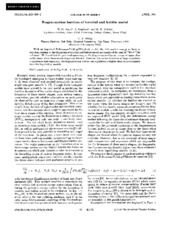| dc.creator | Xu, HM | |
| dc.creator | Gagliardi, Carl A. | |
| dc.creator | Tribble, Robert E. | |
| dc.creator | Wong, C. Y. | |
| dc.date.accessioned | 2011-09-13T21:27:01Z | |
| dc.date.available | 2011-09-13T21:27:01Z | |
| dc.date.issued | 1994 | |
| dc.identifier.citation | H. M. Xu, Carl A. Gagliardi, Robert E. Tribble and C. Y. Wong. Phys.Rev.C 49 R1778-R1782 1994. "Copyright (1994) by the American Physical Society." | en |
| dc.identifier.uri | http://dx.doi.org/10.1103/PhysRevC.49.R1778 | |
| dc.identifier.uri | https://hdl.handle.net/1969.1/126841 | |
| dc.description | Journals published by the American Physical Society can be found at http://publish.aps.org/ | en |
| dc.description.abstract | With an improved Boltzmann-Uehling-Uhlenbeck model, the deformation energy surfaces in reactions leading to the formation of toroidal and bubble nuclei are examined for central Mo-92+Mo-92 collisions. We found that the potential maximum, or the fragmentation barrier, occurs at times close to the times when these exotic shapes are formed. However, due to the dynamics of large amplitude compression and expansion, the fragmentation barriers are significantly higher than those estimated from the liquid-drop models. | en |
| dc.language.iso | en | |
| dc.publisher | American Physical Society | |
| dc.subject | HEAVY-ION COLLISIONS | en |
| dc.subject | STATISTICAL MULTIFRAGMENTATION | en |
| dc.subject | COMPRESSED NUCLEI | en |
| dc.subject | SPHERICAL NUCLEI | en |
| dc.subject | MODEL | en |
| dc.subject | HOT | en |
| dc.subject | TRANSITION | en |
| dc.subject | SIMULATION | en |
| dc.subject | EVOLUTION | en |
| dc.subject | EQUATION | en |
| dc.subject | Physics | en |
| dc.title | Fragmentation Barriers of Toroidal and Bubble Nuclei | en |
| dc.type | Article | en |
| local.department | Physics and Astronomy | en |


